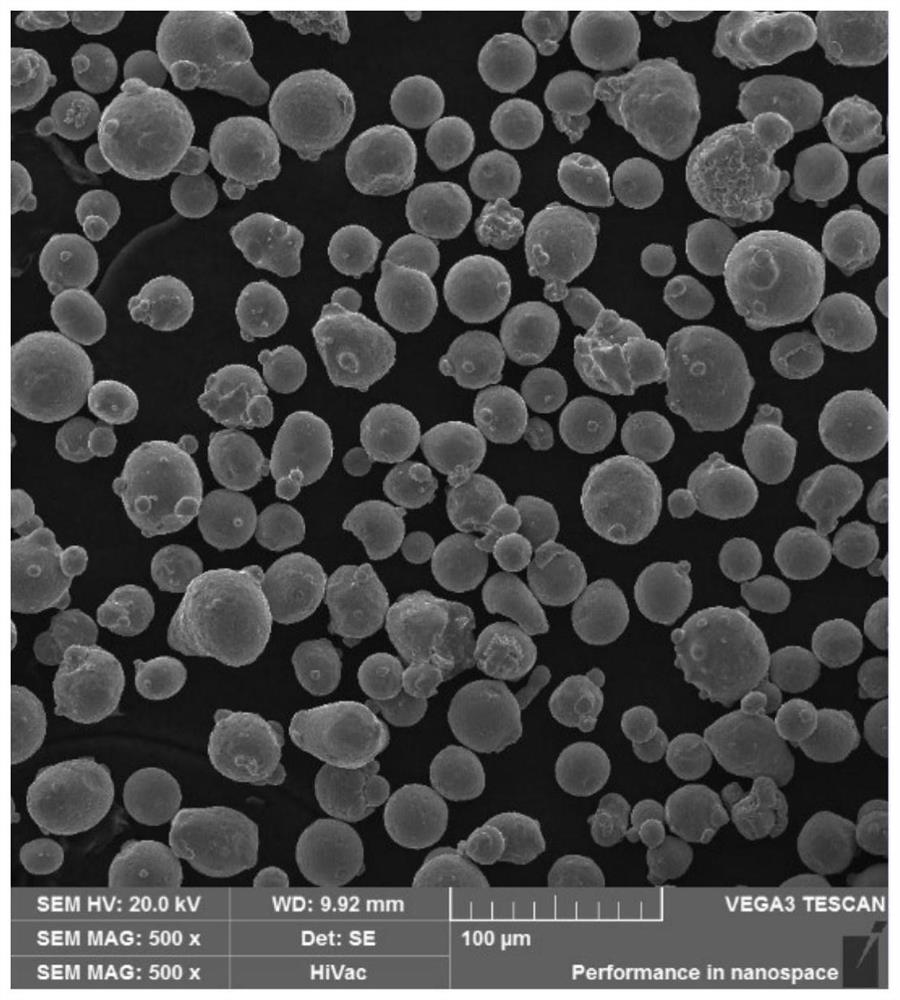Aluminum-lithium alloy material, component and preparation method of aluminum-lithium alloy material
A technology of aluminum-lithium alloy and powder materials, which is applied in the field of aluminum-lithium alloy, can solve problems such as rough surface quality of products, limited application range, etc., and achieve the effects of overall weight reduction, easy process realization, and high controllability
- Summary
- Abstract
- Description
- Claims
- Application Information
AI Technical Summary
Problems solved by technology
Method used
Image
Examples
Embodiment 1
[0043] According to the mass fraction ratio: Mg: 4.5%; Mn: 1.5%; Li: 1.5%; Sc: 0.6%; Zr: 0.3%; The raw materials are vacuum smelted, and the smelting temperature is 770°C. Then, the aluminum-lithium alloy powder was prepared under the atomization gas pressure with argon as the medium, and the atomization pressure was 3.0 MPa. Then air classification is carried out under the protection of nitrogen, and the particle size distribution interval of the powder after classification is 15-53 microns. The classified powder is pretreated at 320°C / 2.5h under an argon atmosphere, and after cooling, it is placed in a selective laser melting device for printing. The printing parameters are: spot diameter 70 microns, powder layer thickness 30 microns, laser power 250w, scanning distance 120 microns, scanning speed 1000mm / s, after printing, place it in a heat treatment furnace and keep it warm for 24 hours at 180°C. The mechanical properties of the product are as follows: tensile strength 5...
Embodiment 2
[0045]According to the mass fraction ratio: Mg: 7%; Mn: 2%; Li: 2%; Sc: 0.5%; Zr: 0.2%; The raw materials are vacuum smelted, and the smelting temperature is 780°C. Then, the aluminum-lithium alloy powder was prepared under the atomization gas pressure with argon as the medium, and the atomization pressure was 3.5 MPa. Then air classification is carried out under the protection of nitrogen, and the particle size distribution interval of the powder after classification is 10-45 microns. The classified powder is pretreated at 300°C / 2.0h under an argon atmosphere, and then placed in a selective laser melting device for printing after cooling. The printing parameters are: spot diameter 70 microns, powder layer thickness 30 microns, laser power 220w, scanning distance 100 microns, scanning speed 800mm / s, after printing, place it in a heat treatment furnace and keep it warm for 24 hours at 180°C. The mechanical properties of the product are as follows: tensile strength 537MPa, ten...
Embodiment 3
[0047] According to the mass fraction ratio: Mg: 3.5%; Mn: 1.0%; Li: 0.5%; Sc: 0.8%; Zr: 0.4%; The raw materials are vacuum smelted, and the smelting temperature is 790°C. Then, the aluminum-lithium alloy powder was prepared under the atomization gas pressure with argon as the medium, and the atomization pressure was 2.8 MPa. Then air classification is carried out under the protection of nitrogen, and the particle size distribution interval of the powder after classification is 15-53 microns. The graded powder is pre-treated at 330°C / 2.0h under an argon atmosphere, and after cooling, it is placed in a selective laser melting device for printing. The printing parameters are: spot diameter 65 microns, powder layer thickness 40 microns, laser power 250w, scanning distance 90 microns, scanning speed 1100mm / s, after printing, place it in a heat treatment furnace and keep it warm for 24 hours at 180°C. The mechanical properties of the product are as follows: tensile strength 555MP...
PUM
| Property | Measurement | Unit |
|---|---|---|
| particle diameter | aaaaa | aaaaa |
| particle diameter | aaaaa | aaaaa |
| density | aaaaa | aaaaa |
Abstract
Description
Claims
Application Information
 Login to View More
Login to View More - R&D
- Intellectual Property
- Life Sciences
- Materials
- Tech Scout
- Unparalleled Data Quality
- Higher Quality Content
- 60% Fewer Hallucinations
Browse by: Latest US Patents, China's latest patents, Technical Efficacy Thesaurus, Application Domain, Technology Topic, Popular Technical Reports.
© 2025 PatSnap. All rights reserved.Legal|Privacy policy|Modern Slavery Act Transparency Statement|Sitemap|About US| Contact US: help@patsnap.com

